Fin-to-limb transition in vertebrate evolution
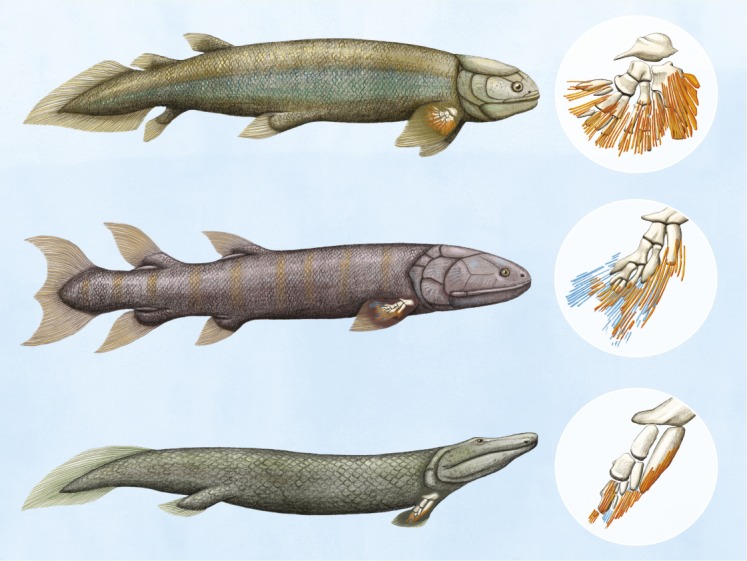
Artist’s reconstruction of tetrapodomorphs. From Top to Bottom: S. taylori, E. foordi, and T. roseae. Dorsal and ventral fin rays shown in orange and blue, respectively. Image courtesy of Alex Boersma (artist).
The transformation of fins into limbs is marked by the appearance of digits, an evolutionary milestone that paralleled the loss of dermal fin rays. Fin rays, which are skeletal rods found beneath the skin and above the endoskeleton, undergird fin webs. Previous efforts to explain the evolution of limbs from fins have largely focused on the underlying endoskeleton. Thomas Stewart et al. (pp. 1612–1620) used computed tomography to examine pectoral fin rays of adult and juvenile specimens of three tetrapodomorph fishes. The fishes—Sauripterus taylori, Eusthenopteron foordi, and Tiktaalik roseae—are thought to be evolutionary antecedents of tetrapods, or four-limbed vertebrates, with T. roseae being closest among them to tetrapods. Comparative analysis revealed a trend in the evolutionary progression toward digits: consolidated fin rays with reduced segmentation and branching, reduced fin webs, and asymmetric coverage of the endoskeleton by dorsal and ventral fin rays. The consolidated rays and foreshortened fins of Tiktaalik, which braved forays onto land, were likely adaptations for maneuvering at the water’s murky bottom or on shallow mudflats. Additionally, the fin rays’ dorsoventral asymmetry suggests that the fin’s ventral surface was more muscular than its dorsal surface at the distal end, akin to a fleshy palm—a feature not previously found in tetrapodomorphs. Thus, the authors suggest, the asymmetry of dermal fin rays, together with previous findings on the endoskeleton and girdle, might help explain Tiktaalik’s upright, fin-supported stance and represent an evolutionary precursor to limb architecture in tetrapods. — P.N.
Drivers of mammal biodiversity
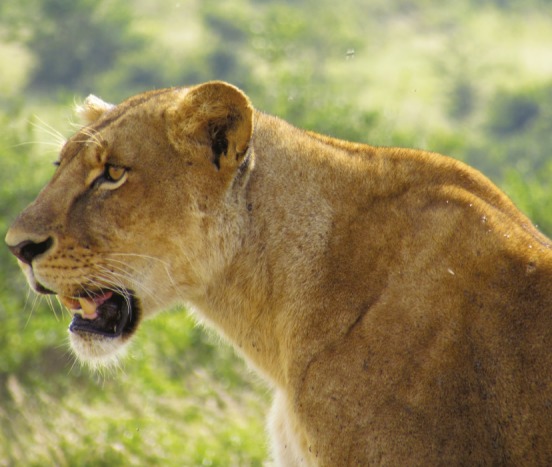
Lioness (Panthera leo) in Nairobi National Park, Kenya.
Studies of biodiversity drivers have typically focused on recent climate and human impacts. However, there is evidence that paleoclimatic change and ancient human activities may influence the structure of present-day plant and animal communities. John Rowan et al. (pp. 1559–1565) compiled a dataset of more than 500 tropical and subtropical mammal communities and examined the extent to which climate and human activities, past and present, could explain aspects of community phylogenetic and ecological structure. The authors found that temperature and precipitation change since the Last Glacial Maximum, around 22,000 years ago, and mid-Holocene warm period, around 6,000 years ago, are significant predictors of community structure in sub-Saharan Africa and Southeast Asia, whereas communities in South and Central America are more strongly predicted by past and present anthropogenic impacts than communities elsewhere. Lemur-dominated communities of Madagascar are poorly predicted by any one factor, likely due to the complex history of the island. Thus, the effects of climatic and anthropogenic factors on community structure vary markedly across geographic regions. The results suggest that the relative importance of ancient and recent climate and human impacts reflects the unique evolutionary and ecological histories of a particular region, according to the authors. — B.D.
How puffins use tools
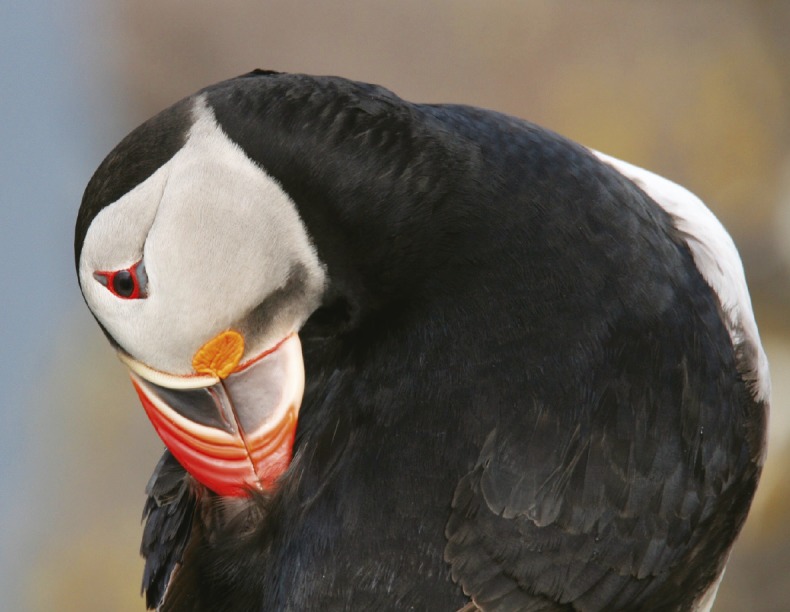
Puffins may use sticks for grooming. Image courtesy of Pixabay/asfafi.
Tool use is rare in animals and mostly seen in primates and passerine birds when they perform complex tasks, often related to feeding. Annette Fayet et al. (pp. 1277–1279) documented two observations of puffins using tools for body care. In the first observation, which occurred in June 2014, a puffin on Skomer Island, Wales, was observed scratching its back with a wooden stick held in its bill. In the second observation, recorded on video in July 2018, a puffin on Grimsey Island, Iceland, picked up a wooden stick from the ground and used it to scratch its chest. The authors posited that the puffins were most likely engaging in grooming by using the stick to dislodge parasites or to scratch. The authors note that puffins on Grimsey Island suffered from an abundance of seabird ticks in 2018, and using a stick may have been more effective than using a beak to dislodge ticks. The findings suggest that occasional tool use may occur in puffin populations, and that the physical cognitive abilities of seabirds may have been underestimated, according to the authors. — M.S.
Physiologically relevant tool for probing liver biology
Primary human hepatocytes (PHH) isolated from the human liver are an important tool for studying liver diseases and drug metabolism, but they have many experimental limitations. Researchers have used various protocols to overcome the limitations, including transplanting PHHs into immunodeficient mice with liver injuries to favor PHH engraftment and expansion. Eleftherios Michailidis, Koen Vercauteren, et al. (pp. 1678–1688) found that the pyrrolizidine alkaloid retrorsine led to an average 10-fold improvement in PHH repopulation in liver-chimeric mouse models and increased the availability of human hepatocytes that could be isolated from the mice. The freshly isolated mouse-passaged (mp) PHH cultures overcame the marked donor-to-donor variability of cryopreserved PHH in terms of plating efficiency. The mpPHH cells could also be maintained for months, making them suitable for long-term drug metabolism studies and long-term analyses of pathogens such as the hepatitis B virus and Plasmodium falciparum. MpPHH cells could be efficiently genetically manipulated in culture, with efficient transduction by lentiviral vectors followed by replating for ex vivo applications or retransplantation to generate highly humanized mice with a genetically modified hepatocyte graft. According to the authors, these advances could facilitate the study of human liver biology and disease. — S.R.
Quorum-sensing inhibitor with therapeutic potential
The human opportunistic pathogen Streptococcus pneumoniae has a molecular quorum-sensing circuit called the competence regulon, which enables the pathogen to acquire antibiotic resistance genes and cause infection. Yifang Yang et al. (pp. 1689–1699) used rational design to develop a quorum-sensing inhibitor with enhanced stability against proteolytic degradation. The competence regulon is mediated by the competence-stimulating peptide (CSP), which exists in two forms—CSP1 and CSP2—resulting in two S. pneumoniae specificity groups. Previous studies have developed dominant-negative CSP analogs (dnCSPs) that inhibit this circuit in either group 1 or group 2 pneumococcal strains but with significantly reduced cross-group inhibition activity. In the current study, the authors designed a potent pneumococcal quorum-sensing inhibitor, CSP1-E1A-cyc(Dap6E10), capable of intercepting the competence regulon in both group 1 and group 2 S. pneumoniae, with activity in the low nanomolar range. CSP1-E1A-cyc(Dap6E10) was found to have enhanced pharmacological properties, such as improved resistance to enzymatic degradation, while remaining nontoxic. In addition, CSP1-E1A-cyc(Dap6E10) was able to strongly attenuate virulence factor expression and mouse mortality during acute pneumonia caused by both group 1 and group 2 strains. The results suggest that CSP1-E1A-cyc(Dap6E10) could effectively attenuate pneumococcus virulence during host infection without inducing strong selective pressure for resistance development and highlight the therapeutic potential of pan-group dnCSPs. — S.R.
Buried impact crater in southern Laos
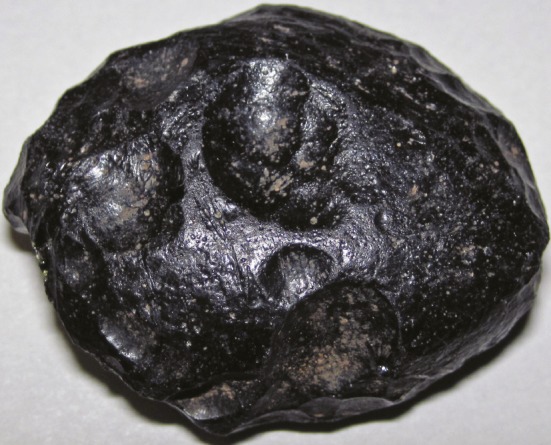
Tektite from the Australasian strewn field. Image courtesy of Flickr/James St. John.
A field strewn with glassy rock fragments, or tektites, produced by a meteorite impact about 790,000 years ago covers approximately a tenth of Earth’s surface. The patterns of tektite size and abundance suggest that the impact occurred in eastern Indochina, but no impact crater has yet been located. Kerry Sieh et al. (pp. 1346–1353) report that the impact site lies buried beneath the Bolaven volcanic field in southern Laos. The geochemical composition of the tektites suggests that most of the variation in elemental composition can be explained by mixing of Mesozoic sandstone and mudstone with varying amounts of volcanic rocks of the type found on the Bolaven Plateau. Argon–argon dating of the lava flows in the region yielded dates younger than the impact in lavas directly above the proposed crater, and dates older than the impact on the periphery of the volcanic field. The authors detected a gravity anomaly consistent with a buried 17x13 km crater. An outcrop 10–20 km southeast of the proposed impact site consists of boulder-sized sandstone and mudstone breccia containing fractured quartz grains, which likely represent proximal ejecta from the impact. According to the authors, the findings are consistent with a buried impact crater beneath the Bolaven field. — B.D.
Land-use history and biodiversity
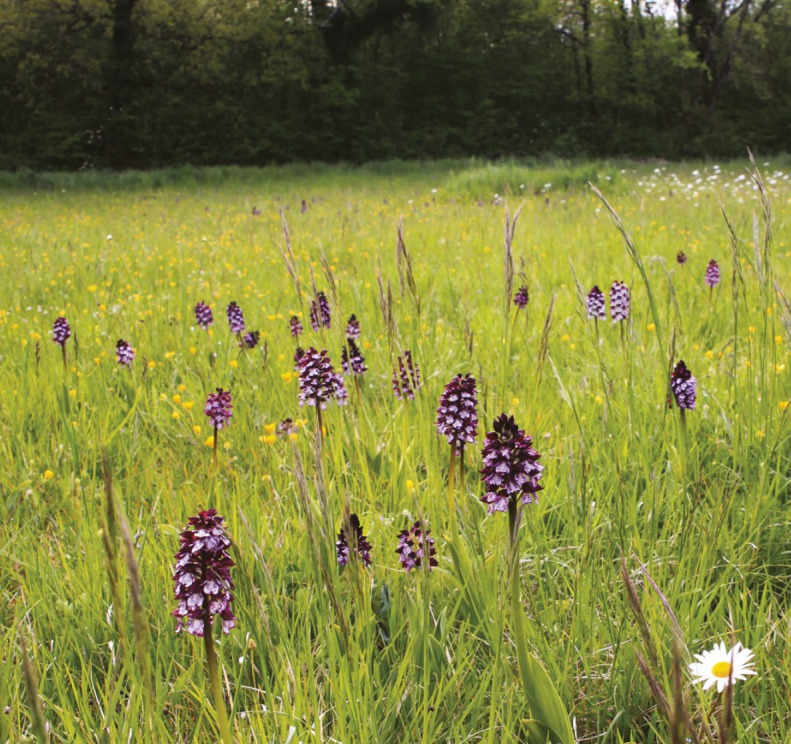
Grassland field surveyed in western France.
The long-term impacts of land-use changes on biodiversity are unclear. Gaëtane Le Provost et al. (pp. 1573–1579) investigated the long-term impacts of land-use history by examining 220,000 records of land use of 75 grassland fields in western France. The records spanned a 20-year period. To account for species’ varying responses to land-use change, the authors measured functional trait diversity, using increased trait diversity, or functional biodiversity, as an indicator of an ecosystem’s ability to weather environmental change. The authors charted body size, mobility, and resource-use traits in seven taxa: vascular plants, wild bees, hoverflies, grasshoppers, carabid beetles, spiders, and birds. In land where historical grassland had been converted to cropland, there was reduced diversity in mobility and resource-use traits such as mandible strength in insects. Functional diversity was relatively high in areas with old, permanent grasslands. The authors found that the impact of the land’s historical use was as strong a factor in functional biodiversity as current use or composition. According to the authors, retention of permanent grassland sanctuaries within intensive landscapes may help offset ecological debts. — T.H.D.


